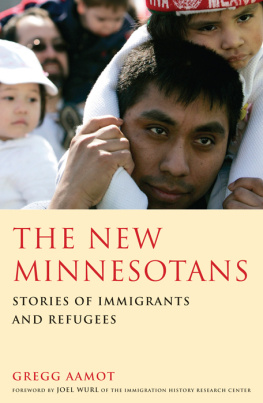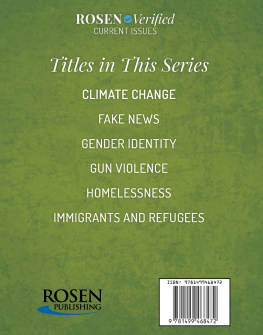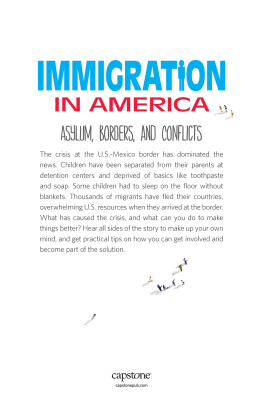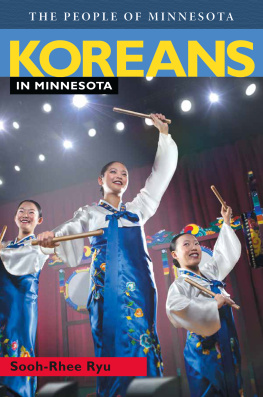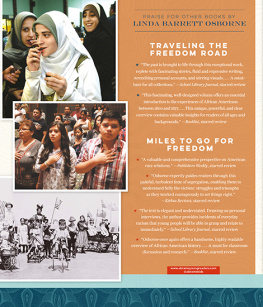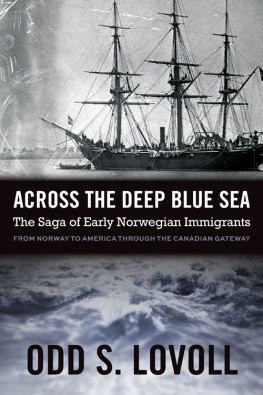THE NEW MINNESOTANS

Stories of Immigrants and Refugees
THE NEW MINNESOTANS

Stories of Immigrants and Refugees
Gregg Aamot
S YREN B OOK C OMPANY
MINNEAPOLIS
Most Syren Books are available at special quantity discounts for bulk purchases for sales promotions, premiums, fund-raising, and educational needs. For details, write
Syren Book Company
Special Sales Department
5120 Cedar Lake Road
Minneapolis, MN 55416
Copyright 2006 by Gregg Aamot
All rights reserved. No part of this publication may be reproduced in any manner whatsoever without the prior written permission of the publisher.
Published by
Syren Book Company
5120 Cedar Lake Road
Minneapolis, MN 55416
Printed in the United States of America on acid-free paper
ISBN-13: 978-0-929636-68-9
ISBN-10: 0-929636-68-6
Ebook ISBN: 978-0-929636-92-4
LCCN 2006930596
Photo credits:
Bea VueBenson: AP photo stringer Janet Hostetter
Chong Thao: AP photo stringer Janet Hostetter
Omar Jamal: AP photographer Ann Heisenfelt
Ali Galaydh: AP photo stringer Andy King
Ahmed Wassie: AP photo stringer Dawn Villella
Gyuto Wheel of Dharma Monastery: AP photographer Jim Mone
Joselyn and Christino Casarez: AP photographer Ann Heisenfelt
Cover design by Kyle G. Hunter
Book design by Wendy Holdman
To order additional copies of this book see the form
at the back of this book or go to www.itascabooks.com
CONTENTS
An Ongoing Problem:
The Hmong Face an Old Tradition
Out There by Ourselves:
Hmong Refugees Help Their Own
Them against Us:
Somalis Find a Unified Voice
A Most Urgent Matter:
Somali Politics, Here and Abroad
Living in Denial:
Ethiopians Take on HIV/AIDS
A Really Big Change:
A Mosque Comes to Minnesota
We Are Here:
Hispanics Shape an Identity
For my parents
and for Jeanne
FOREWORD

As this book is being published, an immigration debate is once again raging in many corners of the nation. Not unlike the widespread and vivid argumentation that played out in newspapers, pamphlets, and legislative chambers a century ago, we are deluged with a steady barrage of rhetoric either extolling the virtues of immigrant contributions to our economic well-being and cultural makeup or decrying the costs of meeting health care and educational needs of newcomers and their impact on social norms. Occupying center stage currently is the issue of how to address the reality of some 12 million unauthorized migrants already in the country with hundreds more arriving daily. Whether legal or illegal, though, at the core of the immigration debate are always two questions: Whom should we welcome? and How many?
Minnesota is one of the states in which these questions are being asked and where immigration is at the forefront of public policy discussion. This would come as a surprise to most non-Minnesotans; indeed, even many in the state are perplexed about why this issue should be receiving persistent high-visibility attention in the media or on Capitol Hill. After all, Minnesotas overall foreign-born population is low compared to several other states of the coastal and southern border regions, as well as low compared to a century ago, when it had one of the nations largest per capita immigrant populations.
But the face of Minnesota is unquestionably changing, and doing so much more rapidly than neighboring states. One of the key explanations for this is the states well-established leadership in refugee resettlement. In 2005, the number of refugees received in Minnesota was surpassed by only that of California. This is not a contemporary anomaly but instead has historical roots stretching back to the immediate postVietnam War era and, in fact, even earlier to the postWorld War II years. The legacy of this commitment has, over the past twenty-five years, brought about the extraordinary infusion of new Minnesotans described in greater detail in this book.
In addition to shining an appropriate spotlight on this evolving demographic and cultural landscape, Gregg Aamots chronicle asks readers to consider the meaning and complexity of assimilation. Scholars, policy makers, and pundits have reached widely varying conclusions regarding the extent to which immigrants should and do assimilate within a dominant society. For many, the term itself embodies the notion of conformity, making it both an inaccurate and an undesirable conception of encounters between immigrants and mainstream culture. Recently, though, the analytical value of assimilation has been somewhat revived. That such assimilation happens, albeit on various levels and time frames, for different individuals and communities, is increasingly hard to deny. But what has become better appreciated today is the equal reality that assimilation is not unidirectional: the mainstream adapts to the immigrant as surely as the immigrant adapts to the mainstream.
A seasoned scholar of migration history once told me that the more she studied the immigrant experience, the more she realized there was no such thing as the immigrant experience. Perhaps more than anything else, the following pages underscore the validity of this point. While we can see some constants across time and among different cultural communities, immigration has always been an intensely human undertaking, and each individual story has something unique to tell us. I urge readers to resist the temptation to extrapolate too many generalities from the chapters that follow and use them to bolster a predetermined point of view in todays immigration debate. Instead, see these stories for what they arethe accounts of particular people in their own particular settings. After all, the ideal outcome of a series of human accounts like this isnt to sway opinion, its to help us better understand our neighbors.
With the rise in immigration in Minnesota and the increasing attention from various quarters, its a bit surprising that we dont yet have a comprehensive study of the topic, past or present. To be sure, the Minnesota Historical Society has published excellent monographs on various immigrant and refugee populations, superseding its earlier reference They Chose Minnesota. The University of Minnesotas Immigration History Research Center provides valuable, unique documentation on the states immigrants. In recent years, studies produced by the League of Women Voters, the Wilder Foundation, Minnesota Advocates for Human Rights, HACER (Hispanic Advocacy and Community Empowerment through Research), the University of Minnesotas Center for Urban and Regional Affairs, the Hmong Cultural Center, the Minnesota State Demographic Center, and various other organizations have enriched our awareness of who has been settling in our state, why they do so, and what kinds of challenges they and their host society encounter.
But it has been especially the work of journalists throughout the state that has built the framework of information available to us on this evolving phenomenon. The best of these contributions have been features that go well beyond the headlines. Aamots book takes us a step furtherbeyond the features. As such, it adds much-needed depth, reflection, and clarity at a time when all of these capacities and more are sorely needed in order to turn fractious debate into constructive dialogue.

